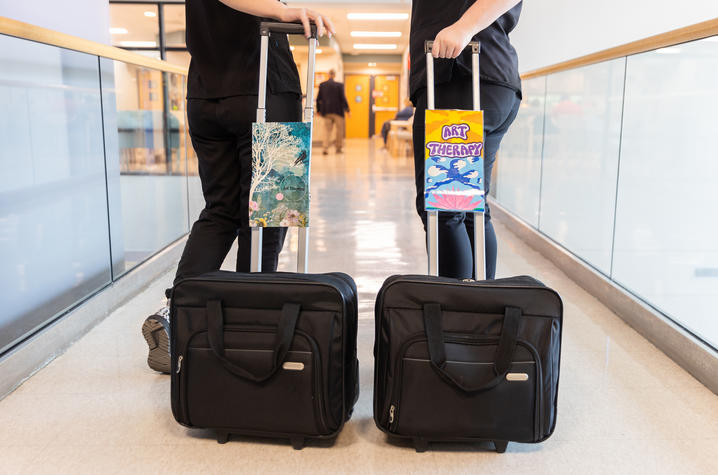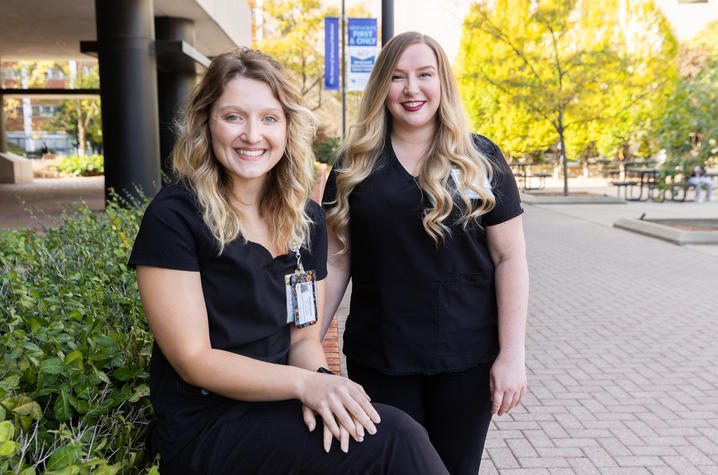Creative care: How art therapy helps UK HealthCare patients heal
LEXINGTON, Ky. (Oct. 24, 2023) — Colored pencils, paint, crochet and scrapbooking might not seem like the usual doctor’s orders. But at UK HealthCare’s Integrative Medicine and Health program, patients and families take part in a unique therapy where art is like medicine.
“A lot of the time people think, ‘Oh you’re just a therapist,’ but no, I’m actually more than that. UK offers art therapy specifically,” said Amber Bruce, one of the licensed art therapists at UK HealthCare.
UK Integrative Medicine and Health focuses on the treatment of the whole person with an emphasis on healing and wellness. Art therapy is provided to nurture the mind-body connection and foster a sense of peace, comfort and overall well-being.
“With research, if you approach the body and a person in a holistic view, their progress in physical symptomatology and mental health increases. So, we’ll see more progress in those patients compared to a person who just has pharmaceuticals to assist with pain management or their symptoms,” said Danielle Creamer, a licensed art therapist associate for Kentucky Children’s Hospital and the Pediatric Behavioral Health Unit.
The art therapists are trained in traditional “talk” therapy, but also to create art during the session with their client. Depending on the age group and goals of each patient, the therapists have different interventions they can use. Art can help not only relieve emotional stress but also physical symptoms such as fatigue, pain and reduced appetite.
“For my kiddos, the youngest I see right now is 3 years old,” said Creamer. “It’s a little different for them right now than teenagers. Their language is play, dance, music and artwork — all the things combined. You have to use different strategies to keep them fully engaged. A lot of the time it is for fine motor skills, sometimes coping or emotional dysregulation things like that. We work on those goals during the art-making process with them.”
Art therapy is for all ages and art experience levels. The therapists use Expressive Therapies Continuum (ETC) and Media Dimension Variables (MDV) models to help decide how to structure their sessions and which mediums should be used based on the patient's needs. ETC looks at physical movement, sensory, symbolic and creative levels of processing. MDV focuses on how fluid or resistive and structured or unstructured an intervention and its materials are.
“With the adults, I typically start off with drawing or colored pencils to get a baseline of where they're at,” said Bruce. “We tailor the art therapy to what the patient feels comfortable with and attempt to move them out of this comfort zone if we work with them continuously. We look to both models (ETC and MDV) to help us make decisions on what materials to bring and what types of goals we set for the patient.”
Patients can work with a variety of art mediums, including colored pencils, crayons, markers, oil pastels, scrapbooking, weaving, crochet, paint, scratch art, clay and collaging. The purpose is to engage with the art materials and express thoughts, emotions and experiences.
“We take a patient-centered approach,” said Creamer. “So, we meet people where they are at.”
Some patients find themselves alone frequently during their stay at the hospital, so the art therapists serve as consistent friendly faces. They bring an interactive component to the patient’s day to motivate them to move, engage and create something. Ultimately this leads to an increase in happiness and ideally, a faster discharge date.
“Since I’ve been here, I’ve seen art therapy bring a lot of joy to patients,” said Bruce. “We’ve been told we are the people who come in and aren’t poking or prodding them. We aren’t doing the medical procedures, we are there to get to know them, be there for them, support them.”
“I hear ‘I can’t, I can’t,’ a lot, but yes you can!” Bruce said. “You just have to try it, and when they do, they are very excited about it. We have patients who are very excited once they create something. It makes them happier.”
And for those who aren’t confident in their artistic ability, Bruce has words of advice.
“Don’t worry about the outcome or what it looks like,” she said. “Just enjoy the process of making art and being creative. A lot of times that is more successful than anything.”
Find more information on art therapy and the UK Integrative Medicine and Health program here.
UK HealthCare is the hospitals and clinics of the University of Kentucky. But it is so much more. It is more than 10,000 dedicated health care professionals committed to providing advanced subspecialty care for the most critically injured and ill patients from the Commonwealth and beyond. It also is the home of the state’s only National Cancer Institute (NCI)-designated Comprehensive Cancer Center, a Level IV Neonatal Intensive Care Unit that cares for the tiniest and sickest newborns and the region’s only Level 1 trauma center.
As an academic research institution, we are continuously pursuing the next generation of cures, treatments, protocols and policies. Our discoveries have the potential to change what’s medically possible within our lifetimes. Our educators and thought leaders are transforming the health care landscape as our six health professions colleges teach the next generation of doctors, nurses, pharmacists and other health care professionals, spreading the highest standards of care. UK HealthCare is the power of advanced medicine committed to creating a healthier Kentucky, now and for generations to come.







